what is the proper order to list accounts on a trial balance
Analyzing and Recording Transactions
17 Ready a Trial Remainder
Once all the monthly transactions have been analyzed, journalized, and posted on a continuous 24-hour interval-to-day basis over the accounting menstruation (a month in our instance), nosotros are ready to offset working on preparing a trial residue (unadjusted). Preparing an unadjusted trial balance is the fourth step in the accounting bike. A trial balance is a list of all accounts in the general ledger that have nonzero balances. A trial balance is an important step in the accounting process, because it helps identify any computational errors throughout the first three steps in the bike.
Annotation that for this step, we are considering our trial residuum to be unadjusted. The unadjusted trial balance in this section includes accounts before they have been adapted. As you meet in step 6 of the accounting bike, we create another trial balance that is adjusted (see The Adjustment Process).
When constructing a trial balance, we must consider a few formatting rules, akin to those requirements for financial statements:
- The header must contain the name of the company, the label of a Trial Residuum (Unadjusted), and the appointment.
- Accounts are listed in the accounting equation social club with assets listed showtime followed by liabilities and finally disinterestedness.
- Amounts at the superlative of each debit and credit column should have a dollar sign.
- When amounts are added, the final effigy in each column should be underscored.
- The totals at the stop of the trial balance demand to accept dollar signs and be double-underscored.
Transferring information from T-accounts to the trial remainder requires consideration of the final balance in each account. If the final rest in the ledger account (T-account) is a debit rest, yous will tape the total in the left cavalcade of the trial balance. If the final residual in the ledger business relationship (T-account) is a credit balance, you will tape the full in the right cavalcade.
Once all ledger accounts and their balances are recorded, the debit and credit columns on the trial residual are totaled to see if the figures in each cavalcade match each other. The final total in the debit column must be the same dollar amount that is adamant in the final credit column. For example, if you lot determine that the last debit balance is $24,000 so the final credit balance in the trial residuum must also be $24,000. If the ii balances are not equal, there is a mistake in at least one of the columns.
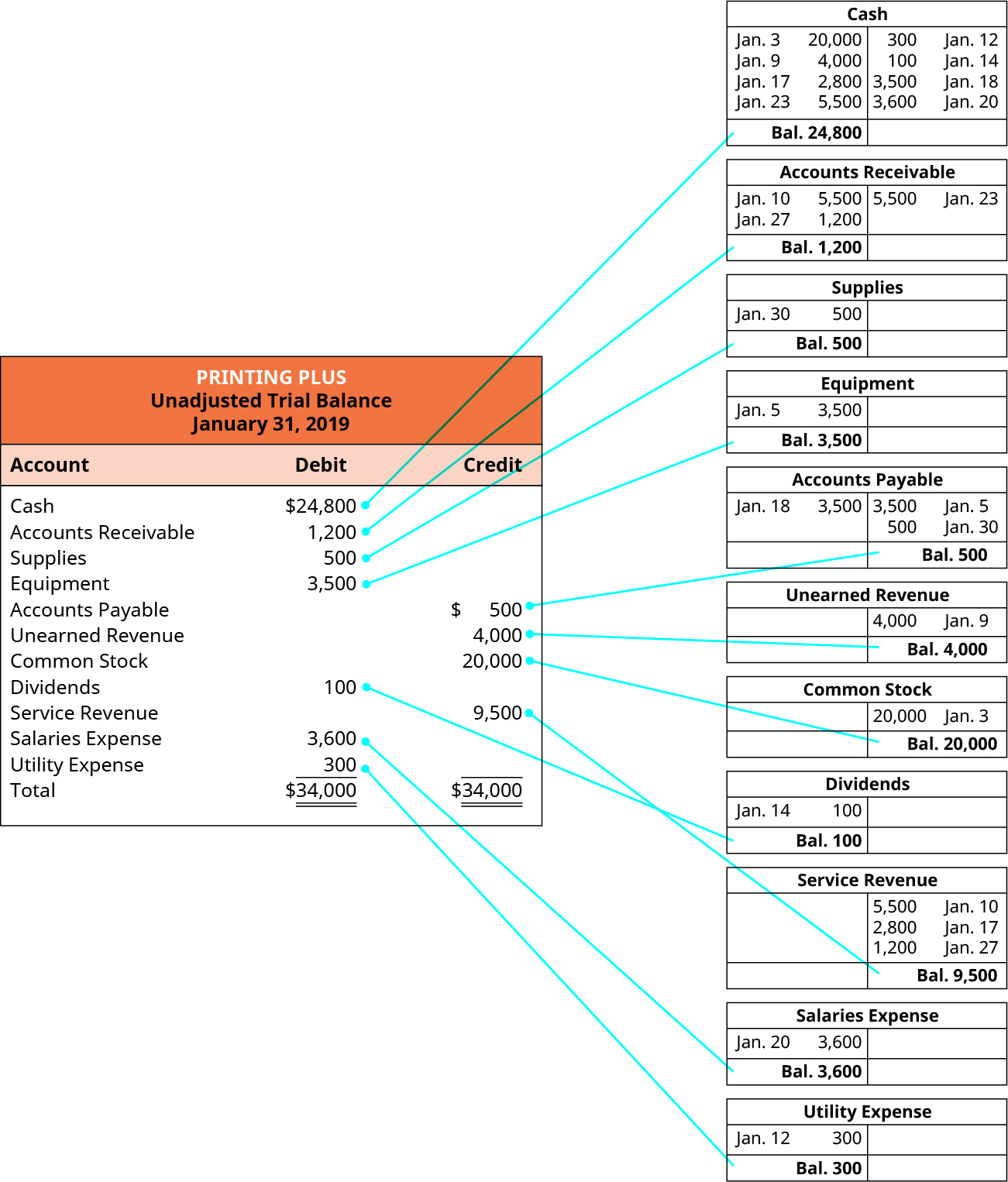
Permit's now take a look at the T-accounts and unadjusted trial balance for Printing Plus to encounter how the information is transferred from the T-accounts to the unadjusted trial balance.
For instance, Cash has a final balance of $24,800 on the debit side. This residual is transferred to the Cash account in the debit cavalcade on the unadjusted trial residue. Accounts Receivable ($i,200), Supplies ($500), Equipment ($3,500), Dividends ($100), Salaries Expense ($3,600), and Utility Expense ($300) also have debit concluding balances in their T-accounts, and so this information will exist transferred to the debit cavalcade on the unadjusted trial balance. Accounts Payable ($500), Unearned Revenue ($4,000), Common Stock ($xx,000) and Service Revenue ($9,500) all have credit final balances in their T-accounts. These credit balances would transfer to the credit column on the unadjusted trial residuum.
Once all balances are transferred to the unadjusted trial residuum, nosotros will sum each of the debit and credit columns. The debit and credit columns both total $34,000, which means they are equal and in balance. However, just because the cavalcade totals are equal and in balance, we are still not guaranteed that a mistake is non present.
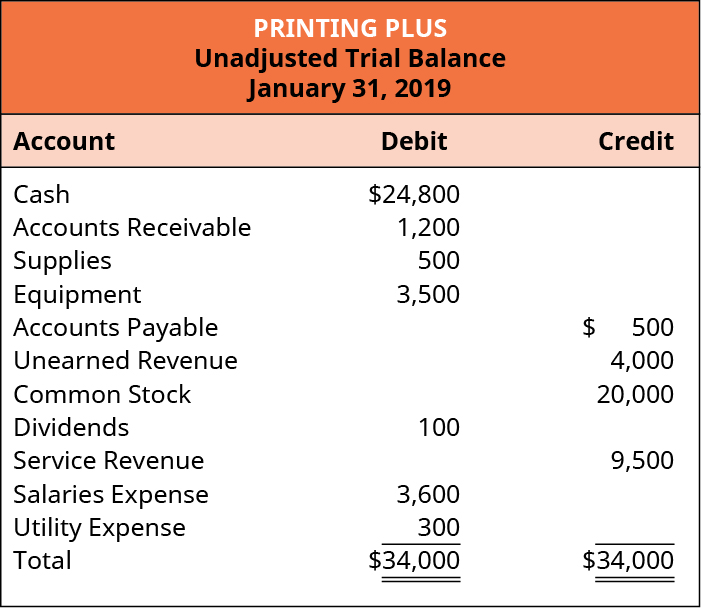
What happens if the columns are non equal?
Enron and Arthur Andersen
One of the most well-known financial schemes is that involving the companies Enron Corporation and Arthur Andersen. Enron defrauded thousands by intentionally inflating revenues that did not exist. Arthur Andersen was the auditing firm in charge of independently verifying the accuracy of Enron'due south financial statements and disclosures. This meant they would review statements to make sure they aligned with GAAP principles, assumptions, and concepts, amid other things.
It has been alleged that Arthur Andersen was negligent in its dealings with Enron and contributed to the collapse of the company. Arthur Andersen was brought up on a charge of obstruction of justice for shredding important documents related to criminal actions by Enron. They were establish guilty but had that conviction overturned. Withal, the damage was done, and the company's reputation prevented it from operating equally it had.i
Locating Errors
Sometimes errors may occur in the accounting process, and the trial residue can brand those errors apparent when it does non balance.
One way to find the error is to accept the deviation betwixt the two totals and divide the deviation by two. For instance, let's assume the post-obit is the trial rest for Printing Plus.
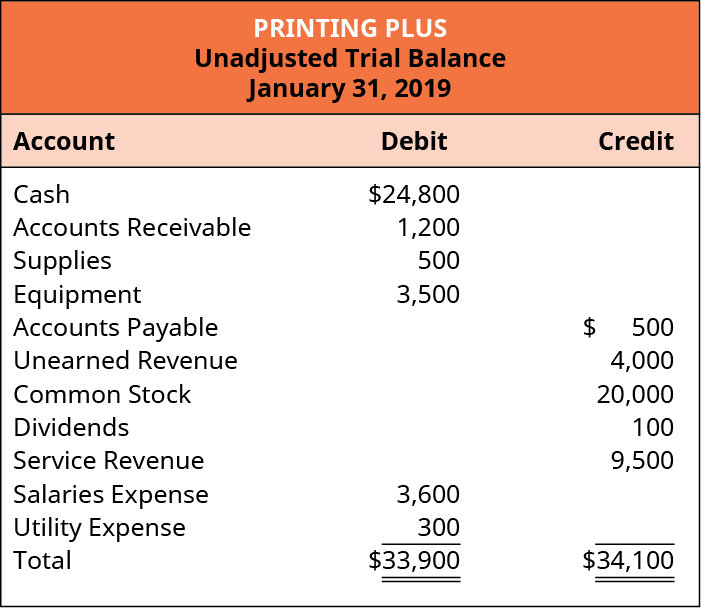
You notice that the balances are not the same. Find the deviation between the 2 totals: $34,100 – $33,900 = $200 difference. Now divide the divergence by two: $200/two = $100. Since the credit side has a higher total, look advisedly at the numbers on the credit side to see if whatsoever of them are $100. The Dividends account has a $100 effigy listed in the credit column. Dividends unremarkably accept a debit balance, but hither it is a credit. Look back at the Dividends T-business relationship to see if it was copied onto the trial residuum incorrectly. If the answer is the aforementioned every bit the T-account, then trace it back to the journal entry to check for mistakes. Yous may discover in your investigation that y'all copied the number from the T-account incorrectly. Fix your error, and the debit full will go up $100 and the credit total down $100 so that they will both at present be $34,000.
Some other style to find an fault is to take the difference betwixt the ii totals and carve up past nine. If the effect of the difference is a whole number, then yous may have transposed a effigy. For example, let's assume the post-obit is the trial balance for Printing Plus.
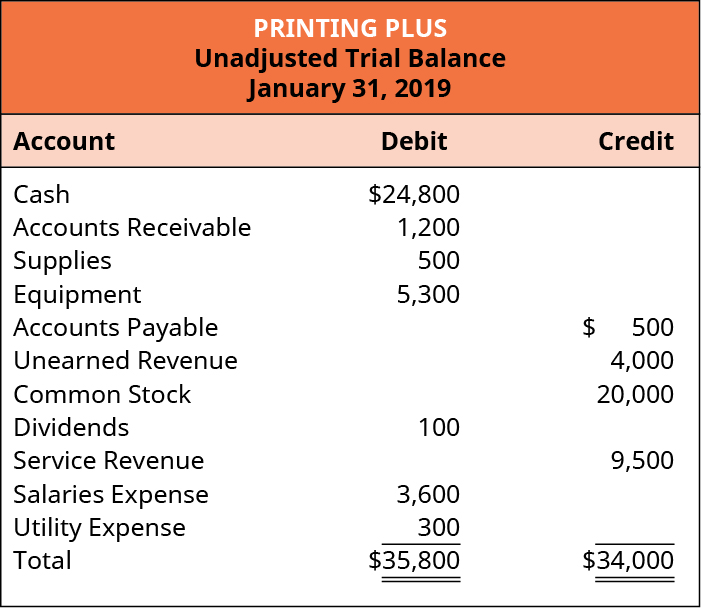
Find the difference between the 2 totals: $35,800 – 34,000 = $1,800 difference. This difference divided by nine is $200 ($i,800/9 = $200). Looking at the debit column, which has the higher total, we determine that the Equipment account had transposed figures. The business relationship should be $iii,500 and non $5,300. We transposed the three and the five.
What do you practise if you have tried both methods and neither has worked? Unfortunately, yous will have to go dorsum through one pace at a time until you lot find the error.
If a trial residue is in balance, does this mean that all of the numbers are right? Non necessarily. We tin have errors and still be mathematically in balance. Information technology is important to become through each step very advisedly and recheck your work often to avoid mistakes early on on in the process.
After the unadjusted trial remainder is prepared and it appears error-complimentary, a visitor might expect at its financial statements to get an thought of the company's position before adjustments are made to certain accounts. A more complete picture of company position develops after adjustments occur, and an adjusted trial balance has been prepared. These side by side steps in the accounting cycle are covered in The Adjustment Procedure.
Completing a Trial Residue
Complete the trial residual for Magnificent Landscaping Service using the following T-account concluding balance data for April 30, 2018.
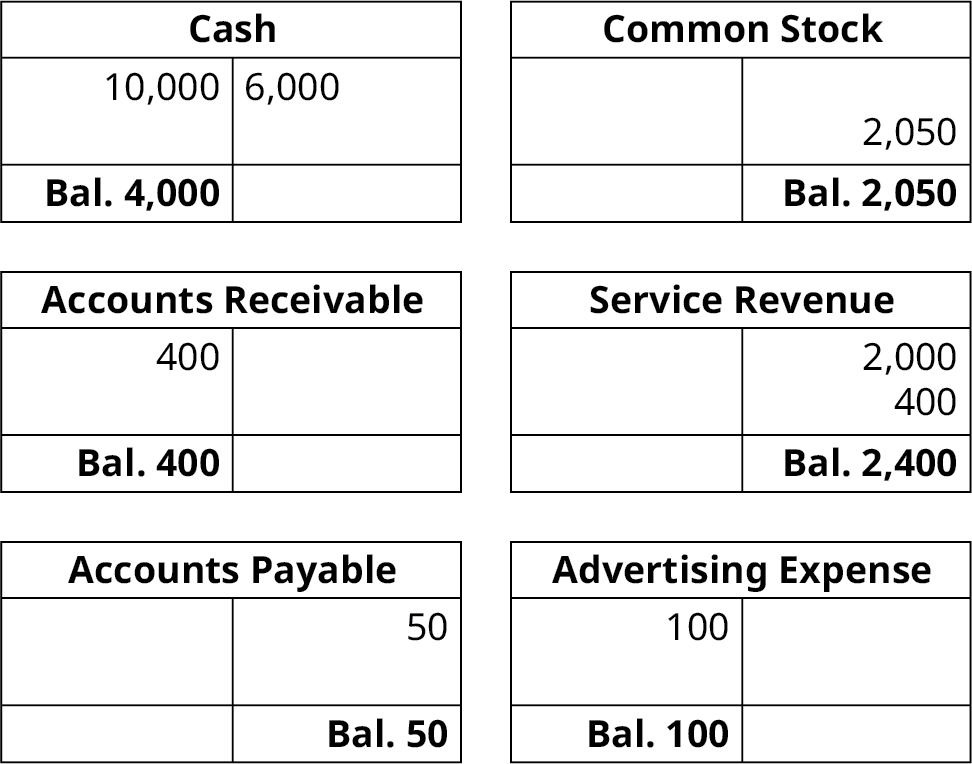
Solution
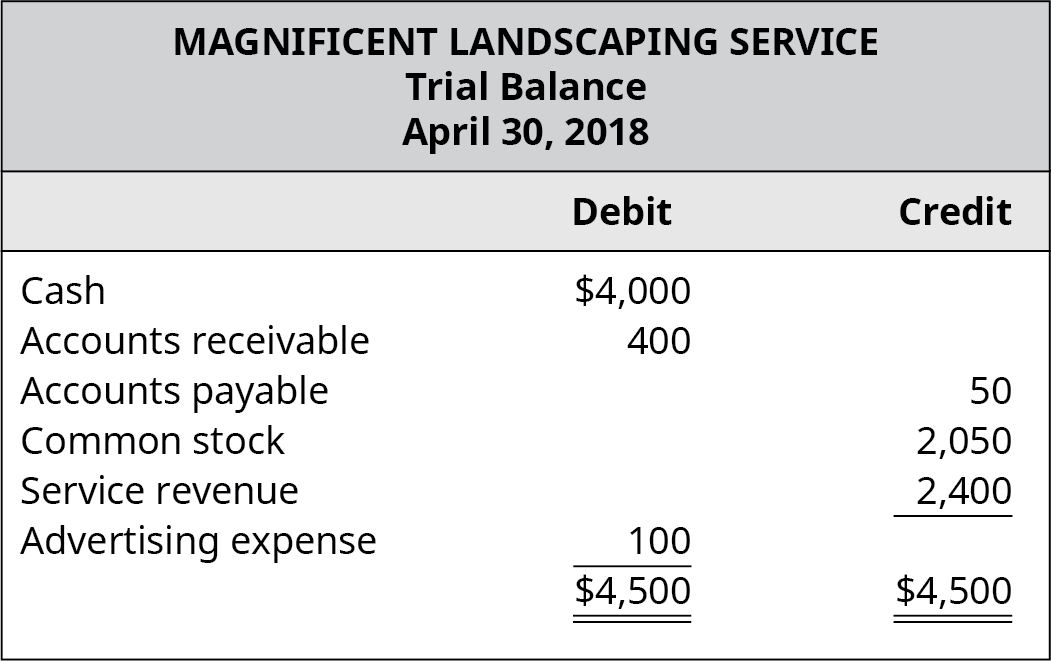
Correcting Errors in the Trial Residual
Y'all ain a small consulting business. Each calendar month, you ready a trial residuum showing your visitor's position. After preparing your trial balance this month, you discover that it does non balance. The debit column shows $two,000 more than dollars than the credit column. You lot make up one's mind to investigate this error.
What methods could y'all employ to observe the error? What are the ramifications if you do non find and fix this error? How can you minimize these types of errors in the time to come?
Key Concepts and Summary
- The trial balance contains a listing of all accounts in the general ledger with nonzero balances. Information is transferred from the T-accounts to the trial balance.
- Sometimes errors occur on the trial residue, and there are means to find these errors. One may have to go through each footstep of the accounting process to locate an fault on the trial balance.
Practise Set A
(Figure)Prepare an unadjusted trial balance, in correct format, from the alphabetized account information as follows. Assume all accounts have normal balances.
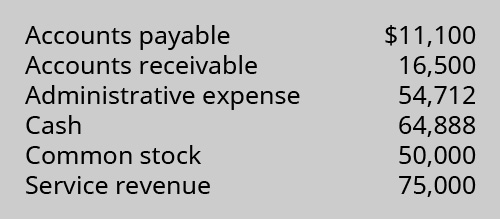
Exercise Fix B
(Effigy)Prepare an unadjusted trial residual, in correct format, from the alphabetized account information every bit follows. Assume all accounts have normal balances.

Problem Set up A
(Figure)Gear up an unadjusted trial balance, in correct format, from the following alphabetized business relationship information. Assume accounts have normal balances.
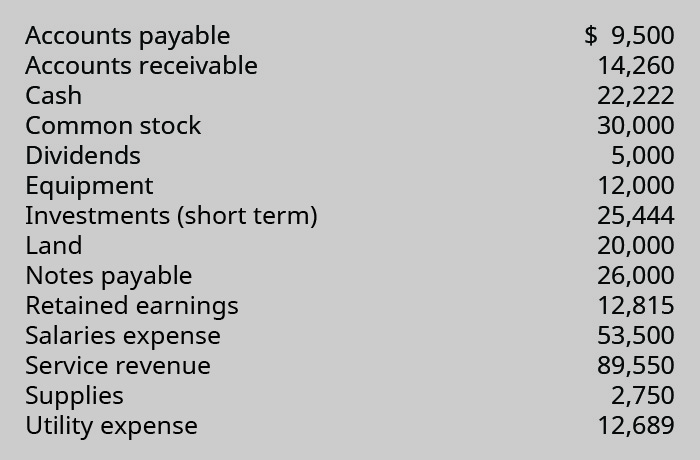
(Figure)Prepare an unadjusted trial balance, in correct format, from the following alphabetized account information. Assume all the accounts have normal balances.
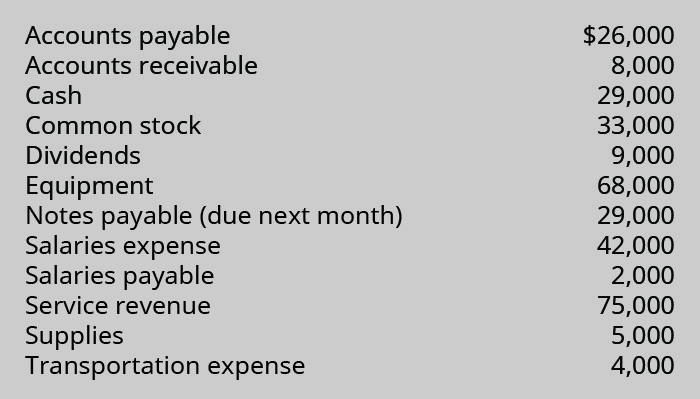
Problem Set B
(Figure)Set an unadjusted trial balance, in correct format, from the following alphabetized account information. Presume all accounts take normal balances.
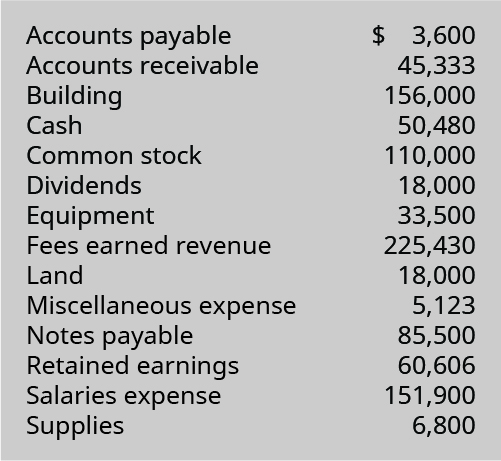
(Figure)Gear up an unadjusted trial balance, in correct format, from the following alphabetized account information. Assume all accounts have normal balances.
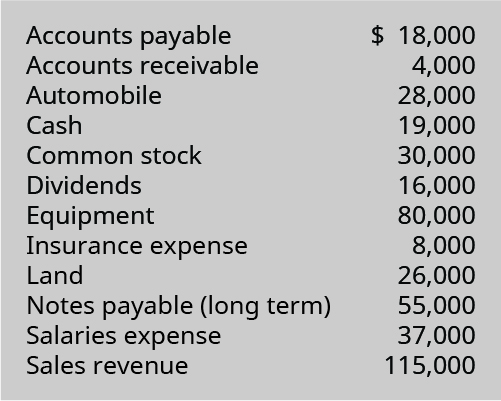
Thought Provokers
(Effigy)Analyze Trusty Company's trial balance and the additional information provided to determine the post-obit:
- what is causing the trial balance to be out of remainder
- any other errors that require corrections that are identified during your analysis
- the effect (if any) that correcting the errors will take on the accounting equation
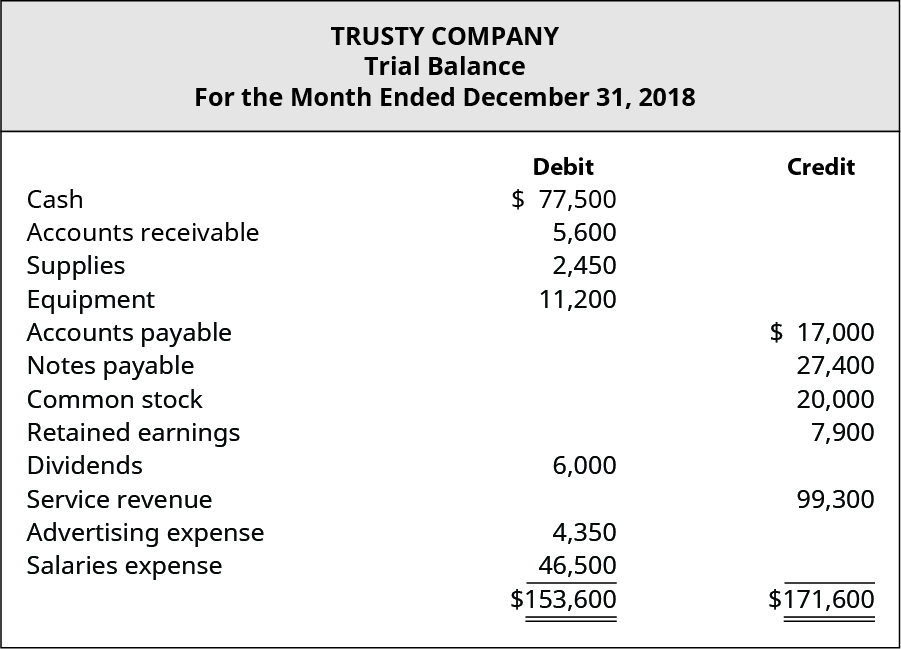
A review of transactions revealed the following facts:
- A service fee of $18,000 was earned (just non yet collected) by the stop of the period but was accidentally non recorded equally revenue at that fourth dimension.
- A transposition error occurred when transferring the account balances from the ledger to the trial balance. Salaries expense should have been listed on the trial residue as $64,500 but was inadvertently recorded every bit $46,500.
- Two machines that cost $nine,000 each were purchased on account but were not recorded in visitor accounting records.
Footnotes
- 1 James Titcomb. "Arthur Andersen Returns 12 Years after Enron Scandal." The Telegraph. September 2, 2014. https://www.telegraph.co.uk/finance/newsbysector/banksandfinance/11069713/Arthur-Andersen-returns-12-years-after-Enron-scandal.html
Glossary
- trial residual
- list of all accounts in the general ledger that have nonzero balances
- unadjusted trial remainder
- trial residual that includes accounts before they have been adjusted
thornhillactem1984.blogspot.com
Source: https://opentextbc.ca/principlesofaccountingv1openstax/chapter/prepare-a-trial-balance/
0 Response to "what is the proper order to list accounts on a trial balance"
Post a Comment